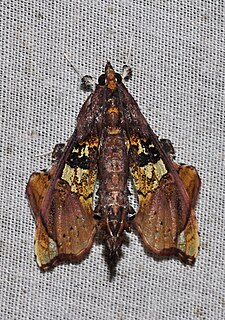
The Crambidae are the grass moth family of lepidopterans. They are variable in appearance, the nominal subfamily Crambinae taking up closely folded postures on grass stems where they are inconspicuous, while other subfamilies include brightly coloured and patterned insects which rest in wing-spread attitudes.

Pyraustinae is a large subfamily of the lepidopteran family Crambidae, the crambid snout moths. It currently includes over 1,400 species, the majority of them tropical but some found in temperate regions including both North America and Europe.

Spilomelinae is a very species-rich subfamily of the lepidopteran family Crambidae, the crambid snout moths. With 4,132 described species in 340 genera worldwide, it is the most speciose group among pyraloids.
Bacotoma is a genus of moths in the subfamily Spilomelinae of the family Crambidae. It currently comprises 11 species, with an Oriental and Australasian distribution ranging from India and Sri Lanka over China and Southeast Asia to Australia.

Hydriris is a genus of pyraloid moths in the tribe Hydririni of the subfamily Spilomelinae.
Hydropionea is a genus of moths of the family Crambidae. The 13 described species are distributed in Central and South America.

Udea is a genus of snout moths in the subfamily Spilomelinae of the family Crambidae. The genus was erected by Achille Guenée in 1845. The currently known 214 species are present on all continents except Antarctica. About 41 species are native to Hawaii.
Plantegumia is a genus of moths of the family Crambidae. The three described species are distributed in Central and South America.

Terastia is a genus of snout moths in the subfamily Spilomelinae of the family Crambidae. It was described by Achille Guenée in 1854 with Terastia meticulosalis as type species. The genus is currently placed in the tribe Margaroniini, where it is closely related to the genera Agathodes and Liopasia.
Glaphyriinae is a subfamily of the lepidopteran family Crambidae. It was described by William Trowbridge Merrifield Forbes in 1923

Lineodini is a tribe of the species-rich subfamily Spilomelinae in the snout moth family Crambidae.
Udeini is a tribe in the species-rich subfamily Spilomelinae in the pyraloid moth family Crambidae. The tribe was erected by Richard Mally, James E. Hayden, Christoph Neinhuis, Bjarte H. Jordal and Matthias Nuss in 2019.
Wurthiini is a tribe of the species-rich subfamily Spilomelinae in the pyraloid moth family Crambidae.
Agroterini is a tribe of the species-rich subfamily Spilomelinae in the pyraloid moth family Crambidae. The tribe was erected by Alexandre Noël Charles Acloque in 1897.

Margaroniini is a tribe of the species-rich subfamily Spilomelinae in the pyraloid moth family Crambidae. The tribe was erected by Charles Swinhoe and Everard Charles Cotes in 1889.
Herpetogrammatini is a tribe of the species-rich subfamily Spilomelinae in the pyraloid moth family Crambidae. The tribe was erected by Richard Mally, James E. Hayden, Christoph Neinhuis, Bjarte H. Jordal and Matthias Nuss in 2019.
Asciodini is a tribe of the species-rich subfamily Spilomelinae in the pyraloid moth family Crambidae. The tribe was erected by Richard Mally, James E. Hayden, Christoph Neinhuis, Bjarte H. Jordal and Matthias Nuss in 2019.
Trichaeini is a tribe of the species-rich subfamily Spilomelinae in the pyraloid moth family Crambidae. The tribe was erected by Richard Mally, James E. Hayden, Christoph Neinhuis, Bjarte H. Jordal and Matthias Nuss in 2019.

Nomophilini is a tribe of the species-rich subfamily Spilomelinae in the pyraloid moth family Crambidae. The tribe was erected by Vladimir Ivanovitsch Kuznetzov and Alexandr A. Stekolnikov in 1979.
Cheverella is a monotypic genus of snout moths in the subfamily Spilomelinae of the family Crambidae. It contains only one species, Cheverella galapagensis, which is endemic to the Galápagos Islands of Ecuador. Both the genus and the species were first described by Bernard Landry in 2011. The genus is placed in the tribe Udeini.












